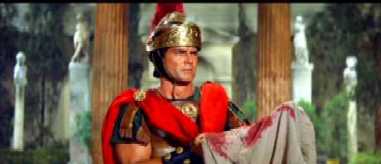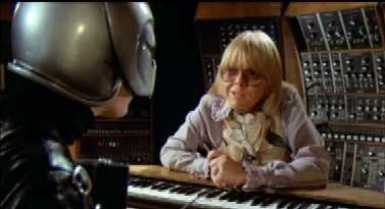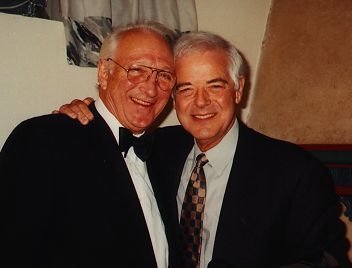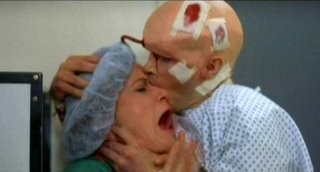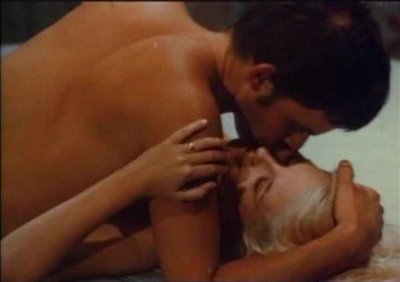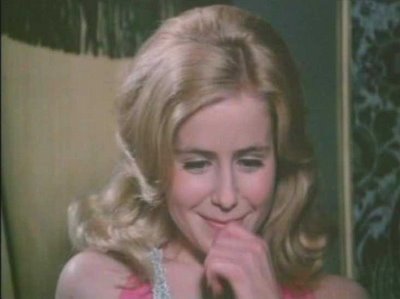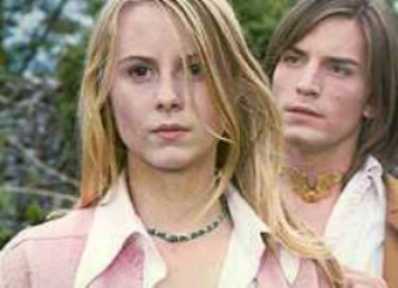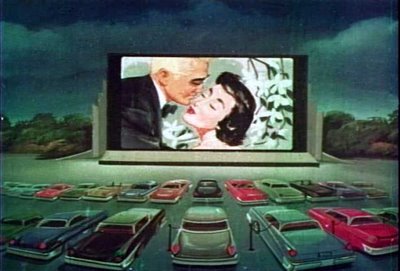
Friday, June 30, 2006
Thursday, June 29, 2006
The 9th Voyage of SnoopBlab, with Lil' Pip

Blab and the Pipster disagree about who should be napping on the comfy chair. Fur will soon fly. Blabber's.
Today is Blabber's 9th birthday -- and also that of his standoffish "twin sister" Snooper (who put the "Sssssss!" in "Princess") -- and it's the day we celebrate Lil' Pip's birthday too, since we imagine he was born at roughly this time of year, being only a few months old at the time we took him in. (Squeaky is two today, and he's been running things almost since he joined us.) And in a coincidence unnoticed till now but sweet in the observance, today also happens to be the birthday of their spiritual animator, Ray Harryhausen -- his 86th. (And if Harryhausen's great composer Bernard Herrmann was still around, he'd be celebrating his 95th natal day today.) Many happy returns to them all, and I include Maestro Herrmann in that salutation, though he's not likely to return except in the form of a new Joel McNeely release. I don't know what awaits Mr. Harryhausen at dinnertime, but our cats get real tuna and a song.

Ah, the lovely ladies of the Lucas abode. Notice which one has the comfy chair.
I think I'll wait till Blabber takes his daily nap in the middle of the living room floor, then put on the 7TH VOYAGE OF SINBAD soundtrack and see what happens...
PS for those who have read THE BOOK OF RENFIELD: You may remember from the dedication page that I mentioned having secreted the names of my past and present pets throughout the novel's text as a gesture of my love and esteem. I honestly don't know if the word "pipsqueak" appears therein, but this lil' pet's given name is Elvis -- which does appear in the penultimate chapter -- but nowadays, we tend to call him that only when he's being reprimanded. Once, when Donna was really driven around the bend by something he did, she used the memorable exclamation, "Elvis PRESLEY!"
Wednesday, June 28, 2006
Phoenix! Phoenix! Phoenix!
Possession is 9/10ths of Guffaw

You'll have to excuse that subject line; I've topped off my evening's viewing with some BEANY & CECIL cartoons and the puns are pouring out of me.
But it's a true enough analogy when it comes to the movie I chose for my evening's main viewing, Amando de Ossorio's EXORCIST rip-off DEMON WITCH CHILD [LA ENDEMONIADA, 1975], which arrived here on VHS many years ago under the Dostoevskian moniker THE POSSESSED. This tape has been in my attic for about twenty years, watched only once, and I was delighted to find that time had stood still in terms of the tape itself; it still plays like it was brand new. The last time I saw DEMON WITCH CHILD, I merely thought it was bad, so I'm even more delighted to discover that my response to the movie today, twenty years further on, is conspicuously richer and more complex. I'm going to write it up for VW's "Things From the Attic" department, so I'm not going to review it here, but I do feel like previewing some of my thoughts on how this film has dated.
If you haven't seen it -- and there's not many opportunities to do so, as it's never turned up on cable, laserdisc or DVD -- it's the story of an old witch, Mother Gaultier ("the Mother of the Old Ones"), who leaps to her death through a glass window after being arrested for the abduction of an infant required by her coven's human sacrifice. (You know that comic "crashing" sound effect? It actually accompanies Mother Gaultier's suicide, right down to the sound of the plate rattling to a standstill.) In turn, her spirit possesses the body of the police commissioner's daughter, Susan. Before you know it, Susan (played by Marián Salgado, who was 11 or 12 at the time but looks somewhat older, thanks to her sexily cascading hair) is questioning the status quo, criticizing the hypocracies of her elders, sneering at the terminally staid, and startling everyone with words like "shit" and "fuck." Her governess (Lone Fleming, from the first two BLIND DEAD pictures) wails, "Her friends couldn't have taught her such words!"
My friends, welcome to the Twilight Zone. The amazing thing about DEMON WITCH CHILD is that, if you look past Susan's levitation (where the tracks doing the lift are in plain sight) and her transformation into Mother Gaultier and her spider-walk down the outside of her house (during which her skirt curiously defies gravity), everything this demonically-possessed child does to arouse terror in the hearts of her parents, caregivers, and local clergy would pass for standard behavior in an American child of her age in the year 2006!
This was 1975, of course. THE LAWRENCE WELK SHOW (or its Spanish equivalent) was still on the air. GIRLS GONE WILD, gangsta rap, and FEAR FACTOR were still no more than glints in the eyes of future pioneers of the arts. It was a different world then. But that doesn't make it any less amazing that, seen today, DEMON WITCH CHILD is only a scene or two removed from a straightforward cautionary tale about the generation gap. In fact, while watching it, I was often less alarmed by the doings of the kid with the snotty attitude than by the ultraconservative, reactionary ways of the adults who encircled her like so many prison bars. That is, until she kills and castrates one of them, and gift-wraps the severed genitals as a present for the victim's girlfriend. That's when Ossorio's movie lets you know, in case you still haven't caught on (as I hadn't), that it's not actually subversive entertainment and has every intention of siding with the grown-ups. Of course, it's possible that the English dubbed version is a travesty and that the original Spanish version is a more sober viewing experience, but I doubt it.
If 35 mm prints of DEMON WITCH CHILD could be found, it might well be the title that could revive the '70s phenomenon of the Midnight Movie. There's nothing that REEFER MADNESS or DAMAGED LIVES have that it doesn't have, and the lousy dubbing adds considerably to its pleasures. I'm in no particular rush to watch my tape of DEMON WITCH CHILD again... but I can't wait to tell my friends about it, and it would be an evening to remember to see it some night in a darkened auditorium with a bunch of of stoned kids out past their curfews.
Would you like to know more? Okay.
Here's a link to an amusing "visual examination" of the film I found online.
And in case you're wondering what Marián Salgado is doing today... incredibly, she's a blogger in Madrid! Her blog is in Spanish of course, and her only entry to date (from what I can understand of it) is sad and possibly tragic in nature; that said, she does seem to be reaching out to others by posting such a message, so I would urge you to proceed there only with the best and kindest of intentions. (And please write to me of anything you find out.) Naturally, I don't hold Ms. Salgado responsible for the shortcomings or the silliness of DEMON WITCH CHILD -- I rather enjoyed her in it -- and her only other movie credit is attached to one of the great classics of Spanish horror: Narcisco Ibañez-Serrador's WOULD YOU KILL A CHILD? aka ISLAND OF THE DAMNED (1976). I sincerely wish her well.
Tuesday, June 27, 2006
The 65th You Never Had

The 65th you never had
A day of smokes and celebration
Your second self abroad is sad
Discarded shadow resignation
Ten years you've gone from here to there
Traced in smoke, transfiguration
Your second self abroad knows where
To find you benched on your vacation
I seek you still, the truth to see
Revealed through smokes and cerebration
Your second self abroad's not me
But gives me grace of expectation.
for Krzysztof Kieslowski
June 27, 1941 - March 13, 1996
THE LAST DAYS OF POMPEII reviewed
THE LAST DAYS OF POMPEII isn't on any list of Naschy films I have seen -- it doesn't help that Naschy's autobiography eliminates all of his pre-starring appearances from his official filmography -- but it was mostly shot in Madrid and at a time when Molina was known to be making screen appearances. In the scene in question, the centurion Glaucus (Reeves) returns to Pompeii after victory in battle and stops to intercede in a Roman guard's flogging of a helpless villager. Glaucus grabs the sadistic guard by the wrist and then you see this:


My apologies for the lousy image compression, but this is as large as I can make the frame without knocking all the information to the right to the bottom of this screen. Yesterday I sent these grabs to various friends, including Naschy authority Mirek Lipinski of Latarnia International, for verification. Mirek agrees there is a resemblance, but otherwise doubts it could be Naschy, as he feels El Hombre Lobo would have spoken before now of having acted opposite someone as iconic and as personally inspirational to him, as an athlete, as Reeves. (PS: Yes, that's Angel Aranda of PLANET OF THE VAMPIRES to the side of Reeves in the second shot.)
You know, having just published these grabs and seen how poorly they communicate what I am talking about, I'm going to blow them up and crop them a bit so you can better see what I saw:
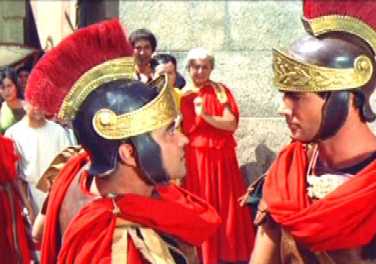

Better, yes? The first one really looks like him, I think... but it's probably not Paul Naschy, so please don't go spreading this rumor all over the Internet; I just wanted to share my surprise with you, and the possibility, shall we say, because I got a bigger kick out of this little eureka than I did from almost everything else this rather turgid epic had to offer.
This DVD was my first opportunity to see THE LAST DAYS OF POMPEII in its correct anamorphic widescreen ratio, and I was disappointed to find that it doesn't hold up very well. The script -- written by a half-dozen old hands at Italian pepla including Ennio De Concini, Sergio Leone, Duccio Tessari and Sergio Corbucci -- plays less like an adaptation of Edward Bulwer-Lytton's novel than a "greatest clichés of the sword-and-sandal genre." The romantic leads meet when Reeves rescues Kaufmann from a runaway chariot; hooded men in the secret employ of Pompeii's High Priest (Fernando Rey) are murdering innocent people and leaving evidence behind to implicate Christians; henchmen deprived of their due are led to a pile of riches that turns out to be fatally booby-trapped; Reeves is chained in a dungeon and tears his way free just in time to save the day -- it's all very familiar. This could have been any other peplum script with an erupting volcano tagged onto the end. The climactic cataclysm is an immense disappointment too, consisting of lots of extras running around under a shower of fireworks sparklers, intercut with stock footage of Vesuvius and optical overlays of fireworks, and only one shot of lava -- which looks more like raw sewage as it feebly engulfs a fleeing man's dropped riches. I hope you know by now that I am not one of those critics who looks down his nose at all movies of this kind; I love a good many of them, from the best to the cheesiest, but this one fails in pretty much every department.
The film's direction is credited to Mario Bonnard, but the aging filmmaker fell ill shortly after production began and he was replaced by his assistant Sergio Leone. (Hence, Leone's "Meisterwerk.") Leone had his own difficulties on the sets in Madrid (he and Reeves didn't get along), and Sergio Corbucci was drafted to direct second-unit scenes at Cinecittà. It was the first of the sandaloni to be produced as a truly epic international co-production, with talent and monies pooled not only from Italy and America, but also from Germany, France, and Monaco; this diversity seems to have been more hindrance than help. Reeves and Kaufmann, speaking English and German at one another, never seem to connect, and the film's villainess, the voluptuous but otherwise boring Barbara Carroll, appears to have been cast solely for her ability to fill Anita Ekberg's old wardrobe from SIGN OF THE GLADIATOR. By far the most expensive peplum produced up to its time, THE LAST DAYS OF POMPEII looks like one of the cheapest -- and the special effects men may have agreed because neither of them worked under their real names. “Magasoli” likely refers to one of two Spanish cinematographers active at the time (Augustín or Antonio Macasoli), while “Erasmo Bacciucchi” was surely the pyrotechnician Eros Bacciucchi. Speaking of which, the screen credits of this film are a veritable madhouse of misinformation -- Sergio Leone himself is credited with directing the second unit!
Laser Paradise's DVD is a deluxe two-disc item that pairs the 1959 film with the 1913 silent version from Italy, directed by Mario Caserini. (Do not confuse the German import with this domestic release, a pan&scan atrocity which also includes the 1913 film as a bonus.) The 1959 version is presented in its original aspect ratio and is generally fine, allowing for some individual scratchy or flecky shots that turn up in otherwise spotless sequences. The color is bold without being overdone. Three different soundtracks are offered in both German or English: original mono, DD 5.1, and DTS 5.1. The latter two principally pack more dimensional, re-recorded sound effects, with some outright fireworks sounds during the scenes of destruction that inadvertently make them more comic. The 5.1 mixes also have a tendency to drown out dialogue and, to an even greater extent, the Angelo Francesco Lavagnino score. The original mono mixes are recommended. The bonus feature (alas, without English intertitles) looks good and is effectively tinted; the red-tinted disaster scenes (likely the uncredited work of Mario Bava's father, Eugenio) seem light years ahead of the remake's capabilities. Cast and crew bios, information about Mt. Vesuvius, and a photo gallery are also included, as are some unrelated promotional trailers.
THE LAST DAYS OF POMPEII (or DIE LETZEN TAGE VON POMPEJI, as the cover art reads) is available here.
Postscript: To the best of my knowledge, this piece marks the English-language debut of the plural term "sandaloni." I found this interesting generic term in an Italian interview with screenwriter Ennio De Concini, published in a history of the Italian production company Galatea. I find this synonym less cumbersome than "sword-and-sandal" and more manly than "peplum," the more compact term assigned to this genre by the French, and I naturally bow to its Italian provenance.
Monday, June 26, 2006
Kate Bush and The Smiths "Under Review"

Since my earlier coverage of the Velvet Underground and Captain Beefheart releases in the series, I've been continuing to follow Sexy Intellectual's "Under Review" titles with keen interest. The latest two I've seen are devoted to the recording careers of Kate Bush and The Smiths. As an American admirer of these artists, one of the most gratifying things about these "Under Review" discs is that they present me with an opportunity to see these artists, who were never very big in America, through the eyes of observers who knew them as the chart-topping celebrities they were in Britain. I've always followed their work, liking pretty much all of it, but without any particular insight as to how their respective careers were affected by the ways in which their various singles and albums managed to hit or miss.
Before getting into the two new releases, I should stop for a moment and correct a common misconception about this series, which seems to be needlessly upsetting some people. The "Under Review" discs are not video compilations, so don't expect complete songs or state-of-the-art quality where video clips are concerned. If that's what you're looking for, you're bound to be disappointed. These discs are, as plainly labelled, "An Independent Critical Analysis"; that is, a visual presentation of music criticism and pop cultural history -- and, as such, I find them very interesting. But I read and like rock criticism.
Of the two new discs, I found the KATE BUSH - UNDER REVIEW most satisfying; in fact, its coverage of her innovations as a video artist and dancer inspired me to spend some money at eBay to acquire someone's (fairly decent) homemade compilation of her videos and various television appearances. The clips on view throughout the program (including some rarities) are mostly of conspicuously better quality than those of the VU and Beefheart releases, which is a definite plus, but the program's greatest value is that the commentators -- including series regular Paul Morley and, in this case especially, BBC Radio 1 DJ Paul Gambaccini -- are so insightful and articulate about Bush's work and its (and her) enduring appeal. Their annotation of all her music, from the uncanny perfection of her debut "Wuthering Heights" single to her recent comeback album AERIAL, I found not only hard to argue with, but often embellishing of my own ideas, and therefore gratifying. The magical quality of Bush's work as a music video artist, dancer, choreographer and director shines through even in short glimpses, and makes the need for a proper, official, DVD release of her work seem essential.
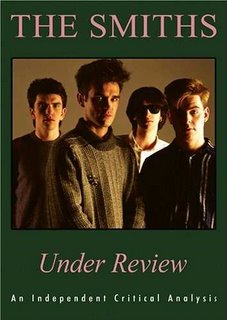
THE SMITHS UNDER REVIEW (which streets tomorrow, June 27) is also of interest, but harder to recommend. It benefits from having access to Smiths producers John Porter and Stephen Street, and also Smiths second guitarist Craig Gannon, all of whom offer more of an insider's perspective of the group's sessions and inter-personal dynamics. However, the program loses some of its integrity because the opinions of the various commentators are so often diffuse and contradictory. I was pleased that at least one participant challenged the common view by arguing that STRANGEWAYS, HERE WE COME was actually their finest album, and even more pleased that the disc had no intention of being "Morrissey - Under Review" in disguise. The contributions of brilliant guitarist-composer Johnny Marr are given at least equal time to Morrissey's, and Andy Rourke's suave and often melodic playing is also accorded proper respect. The clip quality here may be the most consistently good I've seen in this series overall, but the availability of so many TOP OF THE POPS clips and so forth may have inspired the filmmakers to take a more singles-oriented approach to documenting The Smiths' story. In England, The Smiths were widely known as a singles band, but their albums are their great legacy. The posthumously released live album, RANK, is not mentioned at all and the participants monologize on Morrissey and Marr's subsequent solo careers in a bonus featurette.
My feelings about THE SMITHS UNDER REVIEW can basically be boiled down to a single question: "How can I recommend a Smiths career overview that doesn't even mention 'There is a Light That Never Goes Out'?"
Friday, June 23, 2006
A Friday Ramble Through Truth and Beauty

The July 2006 issue of SIGHT & SOUND is on newsstands this week, with Gael Garcia Bernál on the cover. In this month's issue, my "NoZone" column is devoted to the Zeitgeist Films DVD release, WRITER OF O, Pola Rapaport's extraordinary docudrama about Pauline Réàge, the pseudonymous author of the novel THE STORY OF O.
Speaking as a novelist, I find it very rare that any film accurately conveys the passion and interpersonal politics involved in writing fiction, but Ms. Rapaport's grasp of these was so knowing that I found her film an unexpectedly moving experience. Never before in the years I've been writing this column have I ever been motivated to seek out a filmmaker to express my feelings directly, but in this case I did, and I found Pola to be an appreciative and equally generous correspondent. In fact, I was so pleased by the response I got from Pola that I subsequently followed my emotions once again and wrote directly to Jonathan Weiss, the filmmaker responsible for the movie I'm reviewing in the August 2006 S&S, THE ATROCITY EXHIBITION.
I found both of these pictures to be fairly astonishing experiences, and especially in today's world, films made in a spirit of acute honesty and audacity and non-conformity need to be encouraged. Reviews alone would have done the trick, at least the usual trick, but something about the feelings these films awoke (or disturbed) in me encouraged me, for once (well, for twice) to step outside my usual professional boundaries and speak even more directly of their importance and impact to the people who made them.
I wish I had done this with Krzysztof Kieslowski when I first saw THE DOUBLE LIFE OF VERONIQUE, but a film like that (and all the ones that followed) struck me then and still strikes me as the work of a God. I am still astounded whenever I see archival footage of Kieslowski working or being interviewed and see evidence that he was like any number of other people I've known -- rumpled, underslept, carelessly dressed, smoking too much. It also astounds me that all of the amazing women who starred in his greatest films are a decade younger than I am, more or less -- not because I dupe myself into thinking I'm younger than I am, but because these films speak to me with the voice of eternity. They have a power and an inevitability and a perfection that seems to somehow pre-exist not only me, but everything.
Perfection in art has always had that effect on me, as has perfection in design. As a child, I had a terrible time absorbing beauty; I flinched from moments of beauty in movies as much as I hid my eyes during moments of horror. I actually hid my eyes during PINOCCHIO -- not when Lampwick was turning into the donkey (a scene I still find terrifying today), but whenever the Blue Fairy was on the screen, because she was so (too) radiantly beautiful. In the first grade, I can remember a time when the teacher rearranged our desks from the usual parallel queues into clusters of four -- two sets of desks facing one another. To my dismay, I was seated opposite the prettiest little girl in the class (I still remember her name, but I'm not telling you) and started spending all my time either looking down at my desktop or just past her head. If I looked up, I actually began to feel dizzy -- and this is first grade, mind you; it wasn't sexual, it was aesthetic, it was the frigging Stendhal Syndrome. I'm sure I must have feigned illness to skip school a few times just to spare myself those hours of emotional distress. It's a good thing I got over such aversions, but I still carry some emotional residue of them -- like this distance I've tended to impose on myself in regard to filmmakers I admire... or at least those whom I worship, as the case may be.
Perhaps my intense youthful reaction to beauty was the reason why Mario Bava's work spoke to me so directly, with its uncanny knack for tapping the beauty of horror and the ominous power of great beauty. One of my duties this week has been to give my Bava book a final read-through -- my first-ever read-through of an actual-size, illustrated print-out, so this is my first inkling of the power the book is going to have in its final presentation. The pages are in black-and-white at this point, but as I've been making my way through the pages, I have been revisited at times by that old PINOCCHIO feeling -- moved to deep and grateful emotion by the beauty of Bava's aesthetics, and by Donna's confident and potent presentation of my text and the other materials. To my surprise and gratification, I'm finding that reading this book conveys a feeling I never expected: the uncanny sensation of watching a movie.
Without leaving my house, without even loading a camera, I've made a movie too.
Thursday, June 22, 2006
A Call from Mr. Charles Kilgore
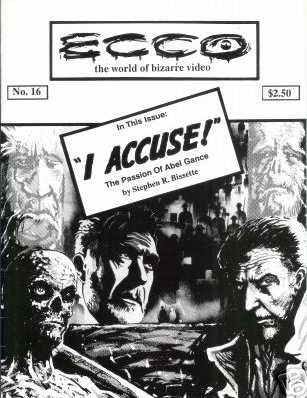
A couple of nights ago, I had occasion to enjoy a lengthy telephone conversation with Charles Kilgore, the erstwhile publisher-editor of the award-winning fanzine ECCO: THE WORLD OF BIZARRE VIDEO. We've been friends for more than sixteen years now, and Donna and I get together for dinner with Charles and the charming Mrs. Kilgore every other year when they visit family in Cincinnati over the holidays. As well as we get along, we speak irregularly -- I don't know why -- so we had a lot of catching up to do. It was good catching up, comparing notes on films and music, and also on matters of life and death. This particular talk was prompted a mutual wish to commiserate in the wake of Audrey Campbell's death, because it was Charles who put her and me in touch initially.
Charles also broke the news to me about the death of another friend we had in common, Sam Stetson, an adult film scholar and researcher who passed away last December 27 as the result of a brain tumor. Sam entered my life many years ago, after VW published a news story about a domestic video release called THE SEDUCTION OF AMY, which turned out to be a retitling of one of Jean Rollin's hardcore films, PHANTASMES (1975). Sam provided me with a copy and he and I swapped tapes for awhile; Sam had also built his own 16mm to video chain set-up, and it was he who provided us with the rare "Captain Howdy" images from the EXORCIST TV spots that we published way back in our 6th issue. In the days before Something Weird and Retro-Seduction Cinema, I got most of my Joe Sarno titles from Sam's collection. He also put me in touch with Joe, with whom I continue to stay in touch by phone... and I, in turn, introduced Sam to the Kilgores, who lived near him. Sam came to Fanex in 1992 to meet EUROPEAN TRASH CINEMA's Craig Ledbetter and me, and I have a lasting memory of his story about working as a taxi driver in Los Angeles in the early 1940s and picking up a hooded fare at a remote house one evening who turned out to be Peter Lorre! As my own interest in adult films is limited, Sam and I gradually fell out of touch, but his friendship with the Kilgores, however, turned out to be lifelong and fortuitous; they were of great assistance to him in his last years, and Charles and his wife were astonished to discover, after Sam's death, that he had willed them his house. Charles and I hadn't spoken since last December, before this happened, and I was sorry to hear about Sam's passing.
Whenever people learn of my friendship with Charles (which is a pseudonym, by the way), they often ask if there's ever going to be another issue of ECCO. Considering that the most recent issue (#22) was published eight years ago, this is quite a compliment -- and a well-deserved one. In a nutshell, ECCO was a literate, intelligent, well-written exploration of the films no one else wanted to write about -- K. Gordon Murray movies, X-rated Westerns, swamp movies, hillbillies in the cinema. It also appeared at a time when these movies were harder to find on video, which made its scholarship all the more remarkable. Over the past eight years, Charles has been promising to do at least one more issue, but when I asked him about ECCO's status this time, I found his intentions somewhat revised.
Now in his 50s, Charles tells me that his retirement is coming up in two years and, rather than try to squeeze out another issue in his spare time at this point in his life, he'd rather wait until he can devote his full time to reviving ECCO. He also said that, if and when ECCO returns, it is likely to reincarnate as an online magazine or blog -- and it won't be returning with the subtitle "THE WORLD OF BIZARRE VIDEO." Since ECCO last appeared, the word "bizarre" has been co-opted by the the rubber and latex fetish communities, and Charles doesn't wish to encourage any misunderstandings -- "You wouldn't believe some of the catalogues and things I get in the mail," he chuckled. He also confessed to having lost a good deal of his interest in exploitation films in the past few years, and said that any reincarnation of ECCO would have to reflect his growing interest in international art cinema to be worth his while.
Whatever ECCO becomes, it will be worth reading... and certainly worth the wait.
Tonight's the Night
Wednesday, June 21, 2006
Remo D. Hits One Hundred
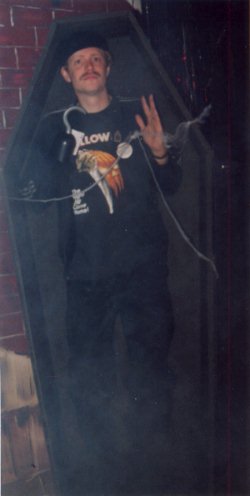
Congratulations are also due to another VW contributor!
Shane M. Dallmann joined our Kennel in 1995 as an eloquent and insightful Godzilla commentator in VIDEO WATCHDOG SPECIAL EDITION #2, and he joined VW properly with issue #46, in 1998. But since January 2002, Shane has been moonlighting as "Remo D.," the debonair horror host of the Monterey, California-based public access telecast REMO D.'S MANOR OF MAYHEM. This coming weekend, Remo D. (pictured) will be serving up his... 100th feature film presentation!
Special times call for special pictures, and this weekend's honored cinematic spectacle will be the 1932 classic THE MOST DANGEROUS GAME, starring Fay Wray, Leslie Banks, and Joel McCrea. Shane promises that the show will be "filled with surprises from both the past and the future!" This milestone broadcast also happens to be coinciding with this weekend's Monster Bash, so if you're attending with a laptop, why not entice some friends up to your room for a MANOR OF MAYHEM viewing party?
Air times are Friday, June 23rd through Sunday, June 25th... Friday and Saturday at 10:00PM Pacific, and Saturday and Sunday at 5:00AM Pacific, and it can be found in the Monterey area on Cable Channel 24 (AMP) or online at http://www.ampmedia.org/ -- choose "Programs" and then "Live Stream" for Channel 24.
Our most frightful felicitations to Shane (a host with a hook, if ever there was one) and all of his crepuscular compatriots in the Manor of Mayhem!
Tuesday, June 20, 2006
CONGRATULATIONS

... to Stephen Jones and VW contributor Kim Newman, whose anthology HORROR: ANOTHER 100 BEST BOOKS has won the Horror Writers Association's coveted Bram Stoker Award for the Best Non-Fiction Book of 2005!
Other Bram Stoker Award winners include:
Novel: CREEPERS by David Morrell and DREAD IN THE BEAST by Charlee Jacob (tie)
First Novel: SCARECROW GODS by Weston Ochse
Long Fiction: "Best New Horror" by Joe Hill
Short Fiction: "We Now Pause for Station Identification" by Gary Braunbeck
Fiction Collection: TWENTIETH CENTURY GHOSTS by Joe Hill
Anthology: DARK DELICACIES edited by Jeff Gelb and Del Howison
Poetry Collection: FREAKCIDENTS by Michael A. Arnzen and SINEATER by Charlee Jacob (tie)
Speciality Press Award: Necessary Evil Press
Richard Laymon / President's Award: Lisa Morton
Lifetime Achievement Award: Peter Straub
VW's Stephen R. Bissette and I were among the contributors to HORROR: ANOTHER 100 BEST BOOKS and we're proud of the book and this victory. It's also presently a nominee for Best Non-Fiction Book on the International Horror Guild Awards ballot (as is Kim's "long fiction" piece for SciFi.com, "The Serial Murders"), and we certainly wish it and him well.
Monday, June 19, 2006
Carburetors, Man. That's What Life is All About.
PHANTOM OF THE PARADISE 1974, Gaumont/Hollywood Classics Limited, DD-2.0 or 5.1/DTS 5.1/MA/LB/16:9/ST/+, $31.95, 87m 48s, PAL DVD-0
 Swan's house band The Juicy Fruits reinvented as Goth act The Undead:
Swan's house band The Juicy Fruits reinvented as Goth act The Undead:Jeffrey Comanor, Harold Oblong (Peter Elbling) and Archie Hahn.
I mentioned performance, but merely mentioning it downplays the fact that everyone here was inspired to give their very best work, and performances such as those given by Jessica Harper, Paul Williams, Gerrit Graham and William Finley (so magnificently unlike his sinister menace in SISTERS) only seem sweeter with the passing of time. Harper, of course, had the talent and charisma to become a major star, not to mention a uniquely smoky gamine quality, but her audacious career choices (INSERTS, PENNIES FROM HEAVEN, SHOCK TREATMENT and, of course, SUSPIRIA) and self-confessed independent streak worked against this, but she's played her career her way and undoubtedly derived great satisfaction from it. Also delightful is MEAN STREETS star George Memmoli as Philbin ("She was more than just a piece to me -- she was the light of my life!"). Had he lived, he would have surely gone on to become a SOPRANOS cast member.
I would love for someone to persuade me otherwise, but I've always found PHANTOM loses its momentum after its climactic rooftop sequence where the Phantom (William Finley) attempts suicide after witnessing a tryst between the evil Swan (Paul Williams) and his beloved interpreter Phoenix (Jessica Harper) and discovers himself and Swan both signed to contracts with the Devil. The remainder of the picture too abruptly switches gears from sprightly dark comedy to outright cynicism and tragedy, and the grand Dionysian finale at the Paradise is too shapeless and uncontrolled a conclusion to a story that is otherwise so well-constructed and resilient in the face of darkness. Had the film ended there, it would have been seriously compromised but, somehow, the end credits montage -- set to an extended take of Williams' rollicking "The Hell of It" -- succeeds in rescuing everything at the last minute. The Nino Rota-like music accompanies a montage of all the casting and performance coups, which is enough to refresh our emotional memory as to how wittily and wonderfully we've just been entertained, and send us out of the viewing experience on a cloud.
A star is born: Jessica Harper as Phoenix.
As mentioned above, the domestic DVD issue of PHANTOM OF THE PARADISE was a serious disappointment. The French disc looks cleaner and moderately sharper, but, for reasons unknown to me, never on home video -- not on Beta, VHS, laserdisc, or DVD -- has the film ever conveyed the sparkle or the vivid presence it had in 35mm. Though the 1.85:1 anamorphic transfer here is a notable improvement, the source elements include individual shots that look noticeably paler than the surrounding material, as if some footage had to be recovered from secondary elements and heavily cleaned. The continuing dullish complexion of the image may have something to do with the extensive optical work imposed on the film in post-production (to replace the "Swan Song" logo with that of "Death Records," when Led Zeppelin's newly-named record label brought suit against the film's producers); in the accompanying documentary, both DePalma and editor Paul Hirsch mourn the loss of the film they originally made, a "sinuous beauty" beside which the known version would be no more than an ugly stepsister. But this can't be the entire explanation because the film had a more lustrous, ebullient look in its initial theatrical playdates. Incidentally, though the packaging specifies this as a Region 2 disc, it is PAL Region 0.
The French disc offers the English and French 2.0 stereo tracks found on the domestic release, as well as brand new DD 5.1 and DTS 5.1 audio remixes. All of the musical performances are post-synchronized, so, even at its best, the music has no "live" presence and the studio recordings have a studied execution that's somewhat at odds with the freewheeling performances. That criticism aside, the presentation of the songs is unfailingly exciting, and DePalma's imagination as a director of musical sequences, hereafter untapped, is one of the film's greatest strengths. All of the soundtrack options are a delight, but the 2.0 mix needs cranking up; once the volume is adjusted, it improves upon the strictly separated stereo channels of the theatrical prints with a still discrete, yet more organic, embracing stereo image. Of the two five-channel mixes, both are outstanding -- what they do with the background vocals is especially revelatory -- but the DTS has the more shapely bass signal to our ears. If only the soundtrack album was available in a 5.1 mix...
 "No one but Phoenix can sing FAUST! Anyone who tries... dies!"
"No one but Phoenix can sing FAUST! Anyone who tries... dies!"A second disc includes "Paradise Regained," a delightful 50m 14s documentary that interviews nearly all of the surviving principals, including producer Edward Pressman, cameraman Larry Pizer, and editor Paul Hirsch (who contributes some of the best anecdotes). One wishes it had been a bit longer, because mention of how the production was slapped with four different lawsuits after Fox acquired the film for $2,000,000 does not explain how these respective suits were satisfied or dropped. People who love the film will be gratified by the actors' acknowledgement of the film's importance to them, and amused by their accounts of encounters with fans over the years. There are two minor sources of frustration. First of all, the documentary was clearly produced with the French DVD in mind, and Gerrit Graham chooses to reply to some questions in unsubtitled French. It's very basic French, though, and not too hard to follow. (Graham also contributes a 50s introduction to the film in French.) Secondly, cast member Archie Hahn is present at the interview of fellow Juicy Fruits member Peter Elbling (who worked under the name "Harold Oblong") but isn't interviewed onscreen, instead popping into frame now and again as Elbling's faux make-up man. His input would have been more desirable than the joke. Other extras include a 10m monologue of reminiscence from costumer Rosanna Norton (welcome but too long by half, frankly), a fake commercial with William Finley pitching a Phantom action figure that was actually once marketed in Japan, two trailers, and a French music video by Bob Sinclar ("I Feel for You") inspired by the "singers audition" scene in PHANTOM.
In the "Paradise Regained" documentary, Jessica Harper observes: "In the film [DePalma] depicts the entertainment business as being sleazy and I think there's no question... it still is sleazy, and it always will be, with a few elements of truth and beauty." PHANTOM OF THE PARADISE is surely one of those elements -- a film very much of its time whose pleasures, like its warnings, somehow never grow old.
The Gaumont disc of PHANTOM OF THE PARADISE is available here.
Thursday, June 15, 2006
In the Nick of Time - Dante DiPaolo!
For those of you who check this blog more often than the other one, the Bava Book blog was updated a few days ago, but there's some other interesting book-related news that I'll post here. Long after giving up hope, I've finally been able to locate and interview Dante DiPaolo, who played important roles in two Mario Bava films, THE GIRL WHO KNEW TOO MUCH (also known as EVIL EYE) and BLOOD AND BLACK LACE.
Two nights ago, I was in Newport, Kentucky at the Shadowbox Cabaret to attend a wake for our late friend, Wayne Perry. Donna and I were looking at photographs of Wayne from throughout his life, when I happened to turn around and find myself face-to-face with Cincinnati broadcasting legend Nick Clooney. Wayne had been the editor of Nick's column for THE CINCINNATI POST, so it was good of him to be there, but I hadn't anticipated meeting him. The nation at large knows this gentleman as an AMC host par excellence and author of the book THE MOVIES THAT CHANGED US: REFLECTIONS ON THE SCREEN, as a Congressional candidate, as the host of the game show MONEY MAZE, or as the father of George. But to those of us were were born and raised in Cincinnati, he's a good deal more.
I have many fond memories of watching Nick's afternoon talk/variety show, circa 1970-75 -- especially the day when John Cassavetes, Ben Gazzara and Peter Falk took over the show to promote their new movie HUSBANDS. (How I'd love to see that again!) He would sometimes sing on that show and released an album called, not entirely inappropriately, SONGS MY PRODUCER WON'T LET ME SING, which I once owned. He later became Cincinnati's local ABC news anchor and was the first competitor to ever wrest the #1 position away from local CBS anchor Al Schottelkotte, whose Walter Winchell approach to news delivery had ruled the 6:00 and 11:00 roosts since the inception of the medium. Nick Clooney humanized Cincinnati news, and rose to prominence here while covering the Beverly Hills supper club fire disaster in 1977. All these impressions were racing through my mind as he kindly thrust out his hand and said, "Hello... Nick Clooney." I tapped Donna's shoulder and introduced them, and we were introduced in turn to Nick's wife Nina, a charming lady whose name I've known almost as long as I've known her husband's.
Of all things I could have discussed with Nick and Nina in the short time we had together -- like Nick's working relationship with the friend we had in common, or his recent headline-making trip with George to the war-ravaged Darfur region of Sudan, to document on film what is happening to the people there -- my mind stupidly zoomed to his album, which sent his kindly gaze briefly ceilingward. (This has got to be like someone asking me to 'fess up to the two fanzines I published as a teenager...) As he was saying something friendly and self-effacing about it, that's when I suddenly remembered that Nick's late sister, the great Rosemary Clooney, had been married to Dante DiPaolo. I had always wanted to interview Dante for the Bava book, but could never locate him -- this was especially frustrating when I learned, in retrospect, that he and Rosemary had wed in a church in the Clooneys' hometown of Maysville, Kentucky -- not a half-hour's drive from my own front door! Dante also turned up a couple of years ago on HBO's UNSCRIPTED, produced by Nick's son George Clooney, in a role that actually harkened back to his role in THE GIRL WHO KNEW TOO MUCH, so I had the feeling that Dante looked back on his work with Mario fondly.
I mentioned my book project to Nick and told him how much I would love to get in touch with Dante, to include his memories therein. He told me that they speak on the phone about once a week, so I gave Nick my number and he promised to pass it along.
He was very prompt about this, which I appreciate. The next morning, we were awakened by a call from Dante DiPaolo (a very early riser) who spoke to Donna (who can sound awake on the phone much faster than I can) as I was pulling myself out of my dreams and eavesdropping on a waking one. Donna and Dante were immediately chatting and laughing together like old pals, and after 15 minutes or so, she took his number so I could return the call. I was able to reach him later in the day. He's now 80, and he had spent the day caring for his 97 year-old mother, who lives next door. He was about five minutes into a recuperative nap before dinner when I called, so it wasn't quite the right time... but, as we were trying to agree upon a better time to have our talk, he started reminiscing and I had the presence of mind to start recording. It was 70 minutes later that he was summoned to dinner, and we had covered most of the bases. I got some good stories from him -- not just about Bava, but pertaining to his work in JOSEPH AND HIS BRETHREN, ATLAS IN THE LAND OF THE CYCLOPS and SAMSON AND THE SEVEN MIRACLES OF THE WORLD -- and, since the layout of the chapters pertaining to his involvement haven't been finalized yet, there is still time to add a couple of pages to those chapters as long as I can transcribe and insert the material properly before Donna reaches that point in her work. She's about 150 pages ahead of where the relevant inserts need to be made, so it won't slow down anything or cause work to be redone to add Dante's memories to the book.
And so, at long last, Dante DiPaolo has become the Bava book's final interviewee. I find a measure of symbolic value in this because, of the more than 100 people interviewed for the book, Dante is the closest-to-home. Dante and Rosemary married in northern Kentucky, as Donna and I did, but their wedding day (November 7) was Donna's birthday as well. The DiPaolo-Clooney connection is the only other Bava-Cincinnati connection besides myself of which I'm aware, so closing my research on the book by talking with Dante is like coming full circle, like Ulysses returning home to Ithaca at the end of a long voyage.
One of the interesting revelations that came from our talk: Dante's first wife is usually mentioned in bios as "a Las Vegas showgirl," but she was actually a French-born model and dancer whose many magazine covers aroused European interest in her for a screen career. She and Dante relocated to Rome and she started making films under the name Nadine Duca, including Riccardo Freda's THE GIANTS OF THESSALY -- that's how Dante made the leap from MGM musicals and dancing in Vegas to appearing in Italian films. Nadia subsequently changed her screen name to Nadia Sanders, making a spy picture for André Hunebelle and doing a fair amount of 1960s American television before retiring from acting. (The IMDb lists separate filmographies for Nadine Duca and Nadia Sanders, assuming them to be two different people.)
"Life being the amazing thing that it is," Dante told me, "she's now my best friend again and, at this very minute, she's calling me in to dinner."
I'll only be using pieces of my interview with Dante DiPaolo for the book, and plan to publish the entire interview in a future issue of VIDEO WATCHDOG.
Wednesday, June 14, 2006
Beyond FROM BEYOND (revised)
I've received a couple of e-mails inquiring whether I saw the director's cut of FROM BEYOND when it ran on Monsters HD the other night. Indeed I did.
I've always liked FROM BEYOND, one of the most ravishing-looking horror films of its period. For all their allure and invention, the neon colors and the strong contrasts between the hot pink lighting and deep blue backgrounds resulted in a fairly sludgy-looking VHS presentation back in the day, so it's a pleasure to see the movie in high-definition and hear the new 5.1 remix. The R-rated running time was 84m 36s, minus the MGM logos, and the new unrated cut clocks in at 85m 16s -- a total of 1m 20s added. The major addition, the eye-sucking scene, is pretty revolting, but in a way that has you chuckling at the outrageousness of it all. Sometimes restored scenes will propel a tentative film toward triumph, but this isn't one of those cases. The restored footage completes the film, but it's not substantially improved by the restoration.
As I say, I've always liked FROM BEYOND. Seeing it complete for the first time, I find I still like it, but with reservations. It's got brilliant ideas, but the scripting (by Dennis Paoli and Stuart Gordon) is uneven, the supporting performances (beyond the three leads) are often amateurish, the special effects are dated and sometimes unconvincing, and the pace is slack at times -- and not entirely because the terror is so cerebral. I love the Resonator. It's no RE-ANIMATOR, but as always, it's a pleasure to see the integrity of art triumph once again over the politics of its time.
POSTSCRIPT 6/15/06: Domenick Fraumeni has contributed a posting to this thread at the Mobius Home Video Forum that details all the additions to the director's cut of FROM BEYOND. I have also amended my comments above to reflect some fact-checking I've done since originally posting this.
Sunday, June 11, 2006
Audrey Campbell, 1929 - 2006
 Audrey Campbell in OLGA'S GIRLS.
Audrey Campbell in OLGA'S GIRLS. Michael Bowen has just notified me of the death of Cincinnati-born Audrey Campbell, best remembered for playing Madame Olga in the sexploitation "roughie" trilogy consisting of WHITE SLAVES OF CHINATOWN, OLGA'S HOUSE OF SHAME and OLGA'S GIRLS -- all made in 1964. The IMDb credits her with only ten feature films, the other notable one being Joe Sarno's macabre SIN IN THE SUBURBS, but she also played minor roles in many a New York-based soap opera, including AS THE WORLD TURNS, THE GUIDING LIGHT, RYAN'S HOPE, even DARK SHADOWS. Audrey died last Thursday, June 8th, concluding what I'm told was a long stay in a New York City hospital, at the age of 76. The cause of her death has not yet been reported, but she suffered from kidney and respiratory problems in recent years.
I once wrote an essay on the Olga films for VIDEO WATCHDOG, which appeared in our sold-out issue #32. At the time, I was able to get Audrey's address from my friend, Charles Kilgore, who had conducted a superb and now definitive interview with her for his fanzine ECCO. (It appeared in #20 and was later reprinted in the booklet included with the Something Weird DVD release of the Olga triple bill of OLGA'S HOUSE OF SHAME, OLGA'S DANCE HALL GIRLS and the film that started it all, WHITE SLAVES OF CHINATOWN. In that interview, Audrey remembered that Andrew Sarris once listed her, Laura Antonelli and Jenny Agutter as his fantasy women in an article for AMERICAN FILM.) I sent a copy of the VW issue containing my essay to Audrey's home address and received from her a card of handwritten thanks that included her home number and an invitation to call. I took her up on the offer one Sunday afternoon (funny how I can remember that detail) and we talked for three hours or more, during which she told me (among other things) that my essay was the finest thing she had ever read about the Olga pictures.
I'll always treasure that memory particularly, but everything she had to say was of interest, especially her stories of the early days of live Cincinnati television. She had her biggest success in local television on WKRC-TV, where she was cast in the wrap-arounds of a bizarre late night movie called THE GIRL IN THE WINDOW. The opening, commercial lead-ins, and closing of each show found Audrey -- then known as Mrs. Audrey Theile -- wandering around her apartment in different $100 nightgowns from Shillito's department store, brushing her hair at her vanity table, filing her nails, getting ready for bed, and finally going to sleep. This 10:00 pm movie aired weeknights in 1956 -- the year I was born; I don't know how many years it ran, but I actually have vague memories of such a program. This marathon call was all on my dime, but I'd gladly have paid for it a second time if I could have had a tape recorder running. Fortunately, Don May Jr. and Synapse Films had the foresight to record an audio commentary with Audrey for their OLGA'S GIRLS DVD.
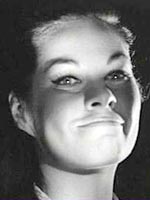
Audrey told me that she and Gerard Malanga (a fellow Cincinnatian) left town around the same time, in 1961, but kept in touch after they arrived independently in New York City. Audrey was courted to followed Gerard into the Warhol Factory crowd, but she never did. However, I suspect that Gerard's familiarity with Audrey's work in the Olga films helped inspire the whip-cracking role that was played in the Velvet Underground's Exploding Plastic Inevitable live stage show by Mary Woronov -- who had a look and presence similar to that of Audrey's Olga. The Olga trilogy actually anticipated Lou Reed's writing of "Venus in Furs" by a couple of years.
Strike, dear mistress, and cure his heart...
Audrey Campbell created one of exploitation cinema's great iconic characters -- a 1960s successor to the sorts of roles Myrna Loy played in the 1930s, but with a more brutal edge -- and she was a bright, vivacious, amazing person. I liked her a lot and wish I'd known she was ill.
Saturday, June 10, 2006
DEN SVENSKA SYNDEN 1969-2000 reviewed
DEN SVENSKA SYNDEN 1969-2000
("Swedish Sin 1969-2000")
1999, Max's Films/Xploited Cinema, DD-2.0/ST/+, 189m 58s, PAL DVD-0
This is something I never expected to see: a three-hour-plus retrospective of Swedish erotic cinema and its evolution (or devolution, depending on your point-of-view) from 35mm film to DTV. It covers exclusively hardcore (XXX) and apparently only work that is owned by the Max's Films label, so that it ends up being a highly indulgent sampler of the firm's product rather than a full-fledged documentary.
Given these unspoken ground rules, DEN SVENSKA SYNDEN necessarily omits a lot of important erotic filmmaking that was done in Sweden. For example, there is no mention of Ingmar Bergman's contribution with films like SUMMER WITH MONIKA, Vilgot Sjöman's 491 or I AM CURIOUS films, Essy Persson, Marie Liljedahl, Christina Lindberg, or the many films that Joe Sarno has made there under his own name (INGA, DADDY DARLING, YOUNG PLAYTHINGS, BUTTERFLIES, etc.) -- all of which would have helped contribute to a fascinating and authentic documentary. That said, what is provided here is organized at least partly as an educational overview and I did learn a good deal from it.
DEN SVENSKA SYNDEN covers a total of 18 different films, giving us the main titles and a lengthy representative excerpt (10 graphic minutes, on average) from each, with informative background narration over the titles. The first two films discussed, Kärlekens språk ("The Language of Love," 1969) and its sequel Mera ur kärlekens språk ("More About the Language of Love," 1970), both directed by Torgny Wickman, are incorrectly described as the first films to graphically depict acts of masturbation and intercourse. (In fact, Matt Cimber's MAN AND WIFE [1969] beat Kärlekens språk into theaters by a few months.) No mention is made of Kärlekens språk being the movie that Robert de Niro drags Cybill Shepherd to see in TAXI DRIVER, but what goes around comes around: the choice of entertainment so offensive to Ms. Shepherd's character was recently the subject of a screening at the American Cinematheque in Los Angeles. It's interesting to learn how these two films got around the Swedish censor by presenting themselves as documentaries based on the research of sex columnists Inge and Sten Hegeler. The filmmakers may have been disingenuous in their approach, but that didn't prevent them from using the opportunity to make their films a valid educational tool as well as exploitatative. In hindsight, one can also see from these excerpts that their clinical approach influenced the Schulmädchen-Report ("Schoolgirl Report") films, a series of anthropological sex comedies that came out of West Germany the following year.
The film proceeds to cover a series of accomplished comedies -- clearly influenced by the Schülmädchen Report films -- made by the pseudonymous "Bent Torn," in fact Mac Ahlberg, who has since directed films under his own name and and today works steadily as a high-profile director of photography (John Landis's INNOCENT BLOOD, Joe Dante's THE SECOND CIVIL WAR, and several films for Stuart Gordon, including FROM BEYOND). Based on their excerpts, these movies -- including Porr i skandalskolan (1974), Justine och Juliette (1975) and Bel Ami (1976) -- had outstanding production values and better-than-capable comic performances, much better than were found in American or even West German sex films of the period. It's obvious that they were made for literate adult audiences who demanded to be entertained as well as aroused. The latter two films also featured the important adult film actress Marie Forså (whose surname, the film teaches us, is pronounced "For-show-a"), a wholesome-looking young woman who made only a dozen films in her career, could really act, and was notable for refusing to participate in hardcore photography though she was often filmed actually having sex with her co-stars.
"Marie Lynn" (Marie Forså) in Mac Ahlberg's JUSTINE AND JULIETTE (1975).
Included in this section is the interesting Den ''K- Släkten (1976), an erotic anthology film by Heinz Ahland which Ms. Forså only narrated. Also, an historic step is documented by the inclusion of Veckända i Stockholm ("Vacation in Stockholm," 1976), the only Swedish hardcore film ever directed by a woman -- Ann-Mari Berglund -- but she doesn't appear to have done much with the opportunity except to also star in it.
DEN SVENSKA SYNDEN arrives at its most compelling stretch with a discussion of two pseudonymous Joe Sarno pictures, Fäbodjäntan (1978, credited to "Lawrence Henning") and Kärleksön (1977, credited to "Hammond Thomas"), which are covered in reverse chronologic order for some reason. The narrator (female, incidentally) surprised me by describing Fäbodjäntan as "the most successful Swedish porn feature of all time," because it's considered an obscure title even among Sarno devotées. It's actually an outstanding example of his hardcore work, with elements of fantasy, and the sex is sometimes tantric in its intensity and spiritual dimension. Sarno had a knack for finding performers who were really into their work and it's clear they are not only enjoying themselves but exploring themselves onscreen. I found this source for a Swedish import DVD double feature of these two Sarno films, also on the Max's label; unfortunately this double-feature doesn't appear to offer English subtitle options, though the excepts from both features included here are subtitled.
A date is set between members of the young cast of Joe Sarno's Fäbodjäntan (1978).
After this, we're a little more than halfway through the program but it's sort of all downhill from there. What distinguishes the sex on view in the first half of the program is that it's all very egalitarian, healthy and unselfish. The women have desire equal to that of the men and pursue it with equal vigor. Just as importantly, it's all skillfully filmed and has a dramatic or historic context that involves you in what's going on. After the Sarno films, DEN SVENSKA SYNDEN embarks on what's hard not to see as a downward spiral, with video taking over from film circa 1986 and the innovations becoming more superficial. When Swedish erotica made the transition to video, it seems to have turned from warm and positive to cold and fetishistic. After a numbing series of mechanical trysts (that frankly had me leaning on my fast-forward key), the program ends with a prolonged, MTV-style encounter between a strutting blonde and a welding-masked stud in a auto repair garage, with sparks flying everywhere -- except between the viewer and the material.
The stage is set for a meaningful relationship in Mike Beck's ?? (that's the title).
Viewing this DVD the day after I watched THE ATROCITY EXHIBITION, I found the index provided by this chronological overview of Swedish erotica as a confirmation of J. G. Ballard's view that our world has become psychotic. DEN SVENSKA SYNDEN begins with material that is healthy and intellectual, instructional and humanistic, but it goes somewhere increasingly abstract, synthetic, and also mildly hostile. There's no trend toward silicone here (which is a plus over the current American porn stars), but pubic hair seems to become a thing of the past as the women become more purely imagistic and increasingly robotic in the second half; the men become less real too, masked phantoms with big muscles. The high-gloss scenarios on view are increasingly sealed off from reality, twisting its viewers' imaginations rather than liberating or indulging them. A near-exception is a "Reality TV"-like segment by Christer Frankell in which an on-the-street interview with a very cute girl becomes an "opportunity" for her to perform in an erotic "screen test." Here the prospect of an initially erotic encounter is soured by the extent to which Frankell and his cameraman exploit this young woman and put her personal safety at risk (they refuse to wear condoms, only promising "you won't get pregnant"). The male arrogance and female subjugation found here, which would have been unthinkable to the people who made Kärlekens språk, is a turn-off... though, with appropriate cynicism, we never doubt for a moment that the entire encounter is staged.
As the grabs included here will attest, the image quality is variable depending on the source. On the whole, the mostly standard ratio presentation looks good for such a densely-packed disc. Some of the clips are letterboxed, if only modestly. The Swedish dialogue has an English subtitling option, the only way a good deal of this material is at all available in English. (The subtitles sometimes lag a bit behind the dialogue they should accompany.) There is also a wealth of trailers for other Max's Film Swedish hardcore releases, one of which features a blurb (in Swedish) attributed to Woody Allen!
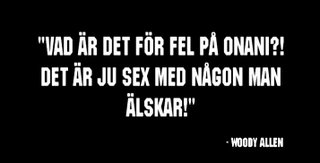
In short, not all of DEN SVENSKA SYNDEN 1969-2000 is necessarily of value, but it's a must for Joe Sarno collectors and a good place to learn more about a genre of serious filmmaking (initially serious, anyway) generally not accessible to English-speaking audiences. It does make one wish that a more genuine, non-partisan documentary existed on the subject, featuring interviews with the participants. Until that unikely chimera descends to earth, you can find DEN SVENSKA SYNDEN here.
POSTSCRIPT 6/15/06: Since this blog was posted, a couple of readers have independently informed me that the apparent "blurb" by Woody Allen is in fact a quotation from ANNIE HALL (1977), translated into Swedish: "Don't knock masturbation! It's sex with someone I love."
Friday, June 09, 2006
For West Coast Readers
"We've got a terrific line-up," he writes, "including David Newman, Lee Holdridge, John Ottman, Chris Young, John Frizzell, John Massari, Bear McCreary and Stu Phillips, plus we have a great selection of CDs on hand to sign, including a few extra goodies to be offered exclusively at the event. For more details, visit www.darkdel.com. We're hoping this signing will be successful enough to make it a regular quarterly event, so please stop by, say hello and show your support!"
Miskalaneous
I am informed by One In The Know that THE GOLDEN ARROW and CAPTAIN SINDBAD are currently owned by Warner Bros., and that the rights to THE WONDERS OF ALADDIN are now likely controlled by Studio Canal. I don't understand how MGM could still own THE THIEF OF BAGHDAD, which was made the same year as THE GOLDEN ARROW and THE WONDERS OF ALADDIN (and by many of the same people), but there you have it.
On another note, reader Michael Swart has written to inform us that Palm Pictures' DVD of Asia Argento's THE HEART IS DECEITFUL ABOVE ALL THINGS (2004) appears to be a defective pressing. "About 80 minutes in," Michael writes, "the disc jumps to the beginning of the next chapter. It does this on both my players, and I know a scene is missing because I saw the film last year - and it's not just any scene, it's a key scene. I made a point of buying the DVD of this film on its release date because I think it's a very good movie that's been unfairly neglected by most critics. The majority of this film's audience will probably see it on home video, so it's unfortunate that this error will spoil their experience of it. Hopefully, these discs will be recalled and a corrected version issued (although a similar problem with Monte Hellman's IGUANA back in the early days of DVD was never corrected)."
I spent most of yesterday working on my next "No Zone" column for SIGHT AND SOUND, devoted to Jonathan Weiss's THE ATROCITY EXHIBITION, an astonishing adaptation of J. G. Ballard's 1970 novel now available as a Dutch import DVD. Not to pre-empt my column, but as an longtime admirer of Ballard and this novel in particular, I was floored by the successful filming of this "unfilmable" work. It's just like the book -- clinical yet savage, non-narrative, non-linear, and full of arresting bits of beauty and ugliness. Strong stuff, but recommended to those who can take it. The disc also includes two audio commentaries, one by Ballard himself, which is the proverbial detail that had me at "hello." You can find it here, or at www.reel23.com.
Finally, I've been asked to remind you all that the World HD Premiere of the "director's cut" of Stuart Gordon's FROM BEYOND will be taking place on Monsters HD on Saturday night, June 10, at 8:00 pm eastern. On Monday, June 12th, Monsters HD is presenting an entire day of AIP programming in honor of the company's late founding father Samuel Z. Arkoff, who would have celebrated his 88th birthday on that date.
Thursday, June 08, 2006
Walking the Plank with Sony's "Midnite Movies"
These are FORTUNES OF CAPTAIN BLOOD/CAPTAIN PIRATE and THE BOY AND THE PIRATES/CRYSTALSTONE ("featuring performances by legendary actors Louis Heyward, Patricia Medina and Charles Herbert," says the press release), each of which will retail for $19.94 -- bumped up from the series' original $14.98 pricing. Perhaps it's someone's idea that these sets are just what mainstream American mateys need to help them count down the hours till the July 7th opening of PIRATES OF THE CARIBBEAN: DEAD MAN'S CHEST, but they could just as easily kill America's Opening Day appetite for skulls and crossbones. Of the four titles included in these sets, only Bert I. Gordon's THE BOY AND THE PIRATES holds any true cult appeal... but then I'm a sucker for a sullen Susan Gordon asking the question "Am I not a cool kid?" Having Timothy Carey aboard as one of the salty cutthroats doesn't hurt either, nor does the enviable fact that I own the Dell tie-in comic book.

But, as "Midnite Movies" go, even the pirattiest among you must admit, these are some pretty dull double-oons. With so much of infinitely greater interest retained in the MGM vaults, it's my guess that whomever is presently in charge of selecting the "Midnite Movies" titles is out of their depth, possibly someone's relative, or an employee who's being punished with the assignment. So I thought I'd offer this poor individual a helpful hand by recommending a couple of other first-rate family-adventure titles in the MGM archives that would make one splendido double-feature package. And before he/she asks, YES! They're both swashbucklers!
I'm speaking of Arthur Lubin's remake of THE THIEF OF BAGHDAD (1961), starring Steve Reeves, and Antonio Margheriti's THE GOLDEN ARROW (also '61), starring Tab Hunter and Rosanna Podestà. Filmed respectively in Tunisia and Egypt, these Italian-American co-productions were both lensed in scope and would look absolutely breathtaking on DVD.

THE THIEF OF BAGHDAD has been out on video before, but only as a pan&scanned VHS from Embassy Home Video released before some of you were born. Steve Reeves was fabulous in the first two Hercules films, of course, but whenever I find myself discussing Reeves with people, it's surprising how often I hear confessions of a special liking for THE THIEF OF BAGHDAD; I wholly agree that it's something special, with one of Reeves' most endearing performances, but I have this old and intractable idea in my head that it's an obscure movie no one's ever heard of -- probably because I didn't get around to seeing it till it was released on home video in the 1980s. But when this movie played in US theaters, it was given the full Joseph E. Levine ballyhoo treatment -- constant television advertising, a Dell tie-in comic book, even a paperback novelization.
Reeves plays Karim, a charming thief (of the Robin Hood variety, stealing from those who can afford to lose and giving to those who cannot afford even simple pleasures), who falls in love at first sight of Amina (CONTEMPT's Georgia Moll), daughter of the Sultan of Baghdad, while robbing the palace. He vies for her hand in marriage against the evil, Conrad Veidtian Prince Osman (BLACK SUNDAY's Arturo Dominici), with whom he sets out to claim his bride by being the first to locate the seven doors that will lead the victor to the fabled Blue Rose. The film's direction is credited to Arthur Lubin, best known for the 1943 PHANTOM OF THE OPERA and the Francis the Talking Mule movies, and Italian sources also credit Bruno Vailati. The special effects are credited solely to Tom Howard (GORGO), but while researching my Mario Bava book, I was told by more than one interviewee that Bava was the film's true special effects supervisor; it really shows, especially in the scene where Karim and his men are besieged by living trees while camping in the desert, which is redolent with Bavian color lighting. (One highlight promised on all the US advertising -- a "gigantic killer crab" -- never materializes onscreen, not even in European prints.) Also praiseworthy is its extraordinarily lyrical score by Carlo Rustichelli, one of his loveliest and most beckoning creations.
To see this film in its correct aspect ratio someday has been a long-cherished dream of mine. The closest I've come to realizing it is a French VHS tape -- even older than the American release! -- called LE VOLEUR DE BAGDAD, which was letterboxed at roughly 1.85 and so still subtantially cropped. This version also included a number of short scenes and snippets cut from the US version, which I hope can be incorporated in the event of a DVD release. It's a wonderful movie.
I recently had the opportunity to see a DVD-R of THE GOLDEN ARROW, one of the very few films which director Antonio Margheriti signed with his own name. (His earlier work had been credited to either Anthony Daisies or Antony Dawson.) His pride was understandable; I've seen a lot of his work and have affection for a good deal of it, but this is one of the best made and entertaining of his pictures. It was made the same year as THIEF OF BAGHDAD, and written by three of the same screenwriters: Augusto Frasinettii, Filippo Sanjust (who seems to have written these and other exotic scripts as a pretext to designing their fabulous costumes) and Bruno Vailati. It's virtually the same story reenacted on some of the same interior Cinecittà sets.

Tab Hunter takes a magic carpet ride in THE GOLDEN ARROW.
Tab Hunter (dubbed by, I think, Jim Dolen) plays Hassan, an orphan adopted and raised by a band of thieves, who is in fact the rightful heir to the throne of Damascus. He falls in love with the Princess Jamila (Rossana Podestà, the heroine of HELEN OF TROY and Margheriti's scary THE VIRGIN OF NUREMBERG) after kidnapping her. Hassan loves Jamila enough to release her, a deed which helps him to win her heart, but he releases her back into her father's plot to marry her off. Three royal contenders win the right to woo her, but are told that, in order to win her hand, they must participate in a contest to bring her the most precious gift of all. Separately, they find a crystal ball, a magic flying carpet, and a liquid that restores life to the dead, but Hassan finally trumps them all with the help of not one, not two, but three genies determined to help him regain his rightful throne -- but only after he learns some important life lessons. (It's clear from the behavior of these genies that there were hopes of hiring The Three Stooges.)
Taken together, these two movies summon a vivid chapter in early movie-going for Baby Boomers, when the combined success of the Hercules films and the Ray Harryhausen mythologies prompted a window of revival for Arabian Nights fantasy. MGM had a big hand in these; come to think of it, I could extend my "Midnite Movies" recommendation to include two other features of the same period and ilk: THE WONDERS OF ALADDIN (1961, starring Donald O'Connor) and CAPTAIN SINDBAD (1963, starring Guy Williams and Heidi Bruhl). No offense to Gordon Douglas, Ralph Murphy and Antonio Paláez (the directors of FORTUNES OF CAPTAIN BLOOD, CAPTAIN PIRATE and CRYSTALSTONE, respectively), but CAPTAIN SINDBAD was directed by a heavy-hitter, Byron Haskin (the original THE WAR OF THE WORLDS, ROBINSON CRUSOE ON MARS), and THE WONDERS OF ALADDIN was co-directed by two, JOURNEY TO THE CENTER OF THE EARTH's Henry Levin and the Italian Maestro of the Macabre, Mario Bava.
I know that Gordon Douglas was a very able filmmaker; he directed DICK TRACY VS. CUEBALL and THEM!, but I was never motivated by their quality to explore the length and breadth of his nearly 100 other films. And I have no idea what CRYSTALSTONE is doing on a DVD with THE BOY AND THE PIRATES; it was made in 1988 -- an entirely different era, with no relevance to nostalgia or double-billing! THE BOY AND THE PIRATES at least has auteur value; in fact, that's just about its only value. I say this with the love.
Unlike these June 27th titles, the movies I've suggested star cult figures whose names people still recognize, they were directed by filmmakers of consequence, and they are fondly remembered by the generation for which they were made. FORTUNES OF CAPTAIN BLOOD and CAPTAIN PIRATE were made in 1950 and 1951, so the audience for which they were made is 10 years older and therefore, regrettably, smaller. Horror and sci-fi sells regardless of decade because these genres appeal to fans and collectors (not to mention fanatical collectors); but when it comes to iffier terrain like B-movie swashbucklers, sticking with Sixties fare is just good business sense.
If Sony/MGM begins to release double features like THE THIEF OF BAGHDAD/THE GOLDEN ARROW and THE WONDERS OF ALADDIN/CAPTAIN SINDBAD, not only are they going to sell, they'll get enthusiastic press, and send out a signal that the people in charge of "Midnite Movies" actually know what they are doing. We want this imprint to succeed... because there's a lot more MGM cult movies where these came from, and if the current titles flop, we may never get our hands on them.
Tuesday, June 06, 2006
BLACK MOON on Flix
I don't understand why the film is so disliked. True, it's not a mainstream feature, but it's a wonderful, creative use of the medium and made with undeniable and often inspired artistry. From what I could gather, BLACK MOON is a kind of ALICE IN WONDERLAND story starring Cathryn Harrison (the stunning 16 year-old daughter of Noel Harrison, looking like the feral kid sister of Catherine Deneuve and Françoise Dorleac) as a young woman who emerges from a car accident into a feature-length dream experience. It takes her to a secluded cottage where she finds naked children chasing an enormous pig, twin siblings (Joe Dallesandro and Alexandra Stewart) intent on killing each other and various animals, and a bedridden old woman who has the ability to communicate with animals (like Cathryn's grandfather Rex!) and makes a smecking sound that periodically alerts the two women in the picture that it's time to bare their breasts and feed her.
Viewers desperately clinging to terra firma will likely have problems navigating this misty mountain fantasmagoria, but the quality of the cinematography alone (by Sven Nykvist) should be enough to keep most film buffs watching, narrative be damned. I was fascinated from the get-go, but as the crazy scenes and incidents accumulated, I began to love the film for its sheer anarchistic invention and humor. I laughed a lot, but most of the time my eyes sparkled in admiration. Some incredible images on view: the absurdly huge rat (almost a baby kangaroo) on the old lady's ham radio... the eagle that comes flying in through the open window, fulfilling the promise of a faded painting on the wall ... the obese unicorn... the scene of Cathryn lifting the old lady out of bed and carrying her around like a rag doll with wasted limbs, while singing to her... Oh, to have witnessed the effect this movie must have had on the stoned-out midnight movie audiences of its day!
Possibly it's not great Malle, but it's great something. For some reason, as I was watching it, I had the idea stuck in my mind that it was a Polanski film rather than a Malle one. I can only tell you that -- what with the black humor, the milk imagery, the dead sheep in the larder, and of course, the splendidly coltish jailbait heroine -- it works as a Polanski film extremely well, perhaps better than it works as a film by Louis Malle. Younger viewers than myself will likely think first of David Lynch as a frame of reference, and it's not unlike the kind of film Lynch would make if he was more of a country boy and less attracted to dark and infernal forces. Despite its tenebrous title, BLACK MOON has surprisingly bright bearing for a weird-out.
BLACK MOON will be showing a few more times on Flix this month (on June 25 at 3:45 am eastern, and on June 25 at 11:35 pm eastern), and on Showtime Beyond next month, so mark your desktop calendars as I have done. Internet searches reveal that it is also being released on DVD in Australia in July, but the Flix master is lovely and windowboxed at 1.66:1 -- very likely a more generous framing than will appear on the official release.
Monday, June 05, 2006
VW 126 At The Printer
 The next issue of VW is now finished and at the printer. Even though printed copies don't exist yet, you can preview the contents of VW 126 by going to the VW website (use the convenient link above, to the right) and clicking on "Coming Soon." Then you can click on the cover to access opening spread previews of the issue's main features: John Bender's feeling tribute to the late Italian film composer Francesco de Masi and my own lengthy article about Edgar Wallace and his role in the creation of KING KONG.
The next issue of VW is now finished and at the printer. Even though printed copies don't exist yet, you can preview the contents of VW 126 by going to the VW website (use the convenient link above, to the right) and clicking on "Coming Soon." Then you can click on the cover to access opening spread previews of the issue's main features: John Bender's feeling tribute to the late Italian film composer Francesco de Masi and my own lengthy article about Edgar Wallace and his role in the creation of KING KONG.Also in this issue: David Kalat's reviews of several recent J-horror titles, Kim Newman on CHARLIE AND THE CHOCOLATE FACTORY and DRACULA II LEGACY (Kim outdid himself in reviewing this one, I thought), Bill Cooke on Jeff Lieberman's JUST BEFORE DAWN, Charlie Largent on the Miss Marple box set, John Charles on FOR YOUR HEIGHT ONLY and CHALLENGE OF THE TIGER, me on the Peter Jackson KING KONG and the second season of THE ADVENTURES OF SUPERMAN, and additional reviews and departments by Anthony Ambrogio, Ramsey Campbell, Shane M. Dallmann, Joe Dante, Richard Harland Smith, Brett Taylor and Douglas E. Winter. In case you've been wondering what Ramsey Campbell decided to write about in the second installment of "Ramsey's Rambles," he selected Nicholas Ray's BIGGER THAN LIFE (1956) -- an inspired choice -- which is available as a French import with optional English audio.
And how's that for a front cover? Charlie Largent took a striking photo from the Peter Jackson KING KONG remake and added a Manhattan skyline and (my favorite touch) some biplanes careening high into our logo. If you go to our site and click on the cover, you'll also get an exclusive preview of the issue's back cover, which pictures the original King Kong holding his favorite magazine!
